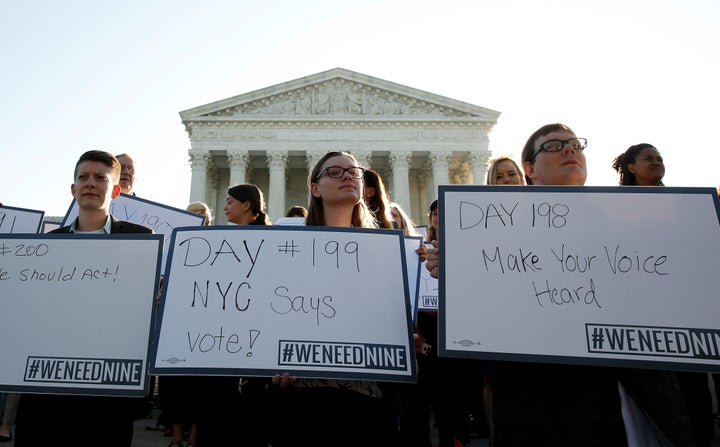
At long last, the future of the Supreme Court came up during a presidential debate, and Hillary Clinton articulated a vision for it Sunday in ways that left Donald Trump babbling little more than talking points.
Who will sit on the high court is a topic that has rallied Democrats and Republicans alike in the run-up to the election, in large part because the next president may get to appoint up to four justices ― securing a legacy that would far outlast a White House stay.
But in answers to what they’d prioritize in their nominations, only Clinton provided a substantive view squarely aimed at her base, hinting that her choices may resemble a justice who’s already serving on the court: Sonia Sotomayor.
“I want to appoint Supreme Court justices who understand the way the world really works, who have real-life experience, who have not just been in a big law firm and maybe clerked for a judge and then gotten on the bench, but maybe they tried more cases,” Clinton said.
The rest of Clinton’s answer centered on core but predictable tenets that an ideal liberal Supreme Court candidate might stand for ― the protection of voting rights, marriage equality and a woman’s right to choose, plus a commitment to getting money and corporate influence out of politics.
But it was Clinton’s description of a justice’s professional background that stood out ― far more specific than Trump’s bumbling reference to the Second Amendment and a pre-manufactured Supreme Court wish list that he said was “very beautifully reviewed by just about everybody.”
(It wasn’t. Republican Sen. Mike Lee of Utah, who wasn’t fond of being included on the list in the first place, has called on Trump to step down from the race.)
Clinton has already said that she’d “look broadly and widely” for justices who represent the country’s diversity. But Sunday’s expanded definition and nod to trial experience fit Sotomayor to a tee, as an Ivy League-educated Puerto Rican woman from the Bronx who cut her teeth as a district attorney in New York before becoming a federal trial judge.
More than other justices in recent months, Sotomayor has been vocal about the Supreme Court’s lack of diversity, telling one audience of lawyers and judges in September that she could not envision her institution matching the nation’s demographics.
“We’re not as diverse as some would like in many important characteristics — educational institutions, religion, places where we come from.”
- Justice Sonia Sotomayor
“The Supreme Court is never going to be a melting pot reflective of the country,” Sotomayor said. “In most of our lifetimes, the court is only going to turn over one full circle.”
That lifetime may very well be now, as three of her current bench mates will be in their 80s during the next presidency, upping their chances of retirement and an opening for a future President Clinton making as many as four appointments. It would mark the first time the court has had a majority of justices appointed by Democratic presidents in several decades.
The threat of a liberal tilt is part of the reason Republicans in the Senate have so staunchly opposed Merrick Garland, President Barack Obama’s choice to replace the late Justice Antonin Scalia. Clinton didn’t mention Garland by name at the debate, but she did call him a “highly qualified person” while she chastised the GOP’s unprecedented blockade of his nomination.
More tellingly, Clinton did not commit to renominating Garland if elected.

That may be because Garland, for all his sterling credentials, doesn’t exactly excite liberals, let alone those who care about criminal justice issues and have reacted with dismay when the Supreme Court fails to place greater checks on police powers. That’s an area where Sotomayor is unafraid to go against the grain, but in which Garland might be keen to give the upper hand to law enforcement ― much like he has in his nearly 20 years on the bench.
That’s nothing to scoff at, and may explain why Obama offered Garland’s name in the first place: he’s a moderate, consensus nominee that Republican senators should be able to get behind. Now that those considerations have fallen on deaf ears, the judge’s only chance ― short of a renomination by Clinton ― is Congress’ lame-duck session, right before the start of the next administration.
If that doesn’t happen, Clinton would have a wide berth to nominate someone younger, more liberal and along the lines of what she envisioned during Sunday’s debate ― people “who understand the way the world really works.”
As Sotomayor told a large gathering at Rutgers University earlier this year, this means going beyond more traditional notions of diversity on the court.
“That’s why I think diversity of all kinds ― and I’m not talking about ethnic or religious alone ― but diversity in professional backgrounds and how people grow up, what they’ve done with their lives is critically important and valuable to the experience of judging,” she said.
